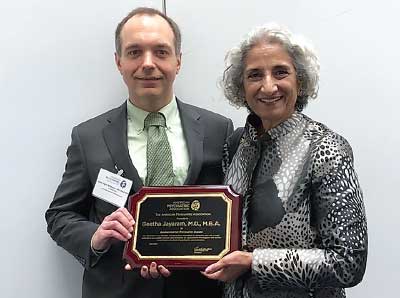Ensuring Patient, Staff Safety Begins With Supportive Management, Staff Training

A psychiatric hospital in London released a violent patient who had been diagnosed with schizophrenia for a one-hour “ground leave.” He headed to a nearby store, bought a set of kitchen knives, and stabbed a cyclist to death.
In a Canadian hospital, a 20-year-old patient died by suicide in a psychiatric unit, using a cord on his bathrobe and a chair in his room. Despite an order for 15-minute checks, he had been left alone for three hours while staff attended a party.
A wider investigation revealed that 300 inpatients over 10 years had died by suicide in Canadian hospitals, all of whom had been on observation with 15-minute checks.
These were some of the safety incidents cited by Geetha Jayaram, M.D., M.B.A., a senior faculty member in psychiatry at the Armstrong Institute of Patient Safety, Public Health, and Nursing at the Johns Hopkins Hospital, at APA’s 2018 Annual Meeting last month. In addition to completed suicides, some of the biggest areas of safety concerns for inpatient psychiatric caregivers are patient aggression and violence, falls with injury, and elopements that end in adverse events. Jayaram has dedicated more than two decades to researching what goes wrong in incidents like these and in realigning hospital practices to prevent them. She has been honored for her work on patient safety as well as residency education leadership and global humanitarian efforts.
Jayaram is the recipient of the 2018 Administrative Psychiatry Award, cosponsored by APA and the American Association of Psychiatric Administrators. In the award lecture she presented at the Annual Meeting, she said what goes right in hospitals with the best safety records is a positive organizational culture, where senior management supports and promotes safety. Also key are creating effective and continuous performance management, as well as building and maintaining a safety-conscious workforce and interdisciplinary teamwork on safety.
Research has shown that men and women of all ages are equally likely to be violent. But patients who experience delusions or hallucinations have a history of hospital violence, seem agitated, are undergoing detox, or say they don’t want to be in the hospital tend to be most prone to acting out, Jayaram said. Nearly half of such patients are verbally aggressive too. “Do not ignore verbal aggression because it’s an early indicator of physical aggression,” she cautioned.
Training nurses to engage patients and work to understand an individual’s needs can give staff needed insight to prevent or diffuse tough situations; one example of a good practice is taking a history of a patient’s previous violence, including inpatient aggression. At Hopkins, all patients admitted to the psychiatric unit are asked within 24 hours what they would like to do if they begin to feel angry and the staff thinks they need to calm down. “For everyone it can be different,” she explained.
Although 98 percent of hospitals surveyed reported using physical restraints daily, hospitals seeking to reduce patient aggression should focus attention on limiting their use. In fact, Jayaram said, restraints should be used only as a last resort.
“There are many other things that can be done to diffuse a tense situation,” she said. She recalled a psychiatric patient who complained to a hospital administrator at Hopkins how diminished and humiliated he felt by being placed in seclusion and restraints. In response, the administrator invited the patient to speak to a group of residents about how the experience made him feel. “No one was allowed to interrupt him,” Jayaram said. “The patient was empowered and felt he had the ability to effect change, and believe me, the staff will be far more careful before they say ‘Let’s put someone in seclusion’ again.”
Despite the fact that the biggest risk in psychiatric units is completed suicides, the weakest link is that the least-trained patient care staff tend to be those who are charged with watching over patients at highest risk of self-harm, Jayaram has found. In a completed suicide she investigated at another hospital, the observer did not understand that the patient should not have been permitted to close the door while alone in the bathroom. At Hopkins, a suicide risk assessment is done daily, and nurses document why a patient needs an observer. The hospital has not had a completed suicide in 33 years.
|
|
|
|
|

